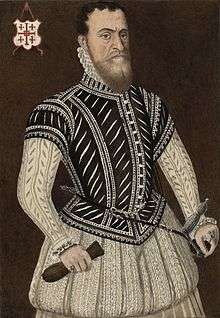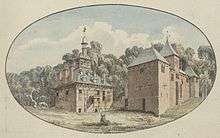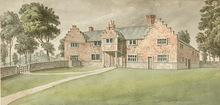Richard Clough
Sir Richard Clough (c. 1530–1570), known by his Welsh contemporaries as Rhisiart Clwch, was a merchant from Denbigh, north-east Wales, and an agent of Queen Elizabeth I of England.

Early life
Clough was from a humble background, but his fortunes were improved when he was noticed, as a boy chorister in Chester Cathedral, for his remarkable singing voice and was sent to court in London:
- "Some were so affected by his singing therein, that they were loath he should lose himself in empty air (church musick beginning then to be dis-countenanced) and persuaded, yea, procured his removal to London".[1]
By virtue of his visit to Jerusalem, he became a Knight of the Holy Sepulchre. Back in London, he became a factor (or manager) for Thomas Gresham and entered the Mercers' Company.
Trader in Antwerp
In 1552 he was located in Antwerp, then the centre of North European commerce and banking. Here he met his wife Catherine Muldart, from that city. With her, he had a son, Richard. In 1561, he wrote to Gresham – his employer – with the suggestion that something along the lines of the Antwerp Bourse could be established in London. Gresham took this up, founding the London Royal Exchange, which opened in 1571. Clough played an important role in its development, providing finance and appointing Hendrik van Passe, the Flemish architect to work on the building. Many of his lengthy letters, which were passed by Gresham to the government for their use in intelligence, have survived and been used by historians. His eyewitness account of the "Iconoclastic Fury" or Beeldenstorm in Antwerp in 1566, is often quoted. He saw: "all the churches, chapels and houses of religion utterly defaced, and no kind of thing left whole within them, but broken and utterly destroyed, being done after such order and by so few folks that it is to be marvelled at." The Church of Our Lady in Antwerp, later made the cathedral: "looked like a hell, with above 10,000 torches burning, and such a noise as if heaven and earth had got together, with falling of images and beating down of costly works, such sort that the spoil was so great that a man could not well pass through the church. So that in fine [short], I cannot write you in x sheets of paper the strange sight I saw there, organs and all destroyed."[2][3]
Return to Wales


Clough returned to Wales in 1565, and introduced Flemish building styles into the area with the building of two houses, Bach-y-graig and Plas Clough. He was so rich that in his home area his name became a synonym for wealth. He devised a scheme to dredge the River Clwyd and make it navigable.
He was active in astronomy, a patron of the map publisher Humphrey Llwyd of Denbigh and friends with Ortelius. In 1567, he was named "court master" of the London Merchant Adventures, now resettled from Antwerp to Hamburg. He died unexpectedly in Hamburg, some time between March and July 1570, while preparing to bring his second wife, Katheryn of Berain, home to the new house he had built for her at Plas Clough on the outskirts of Denbigh.
In local folk-tales of Tremeirchion, Clough is supposed to have been carried off by the Devil, never to be seen again, after being discovered by his wife discussing alchemy and other "godless" subjects at the house he had built for her.
Notes
- Worthies of England by Thomas Fuller, 1662
- Spicer, 109 (spelling modernized); see also Arnade, 146–148
- Eyewitness Account of Image-breaking at Antwerp Archived 2012-07-09 at Archive.today, Universiteit Leiden
References
- Sir Richard Clough — "The Most Complete Man"
- Arnade, Peter J., Beggars, Iconoclasts, and Civic Patriots: the Political Culture of the Dutch Revolt, Cornell University Press, 2008, ISBN 0-8014-7496-5, ISBN 978-0-8014-7496-5
- Spicer, Calvinist churches in early modern Europe, Manchester University Press, 2007, ISBN 0-7190-5487-7, ISBN 978-0-7190-5487-7